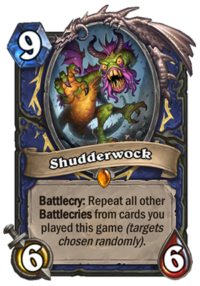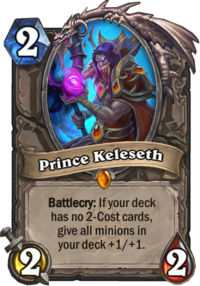Our Tempo Shudderwock Shaman deck list guide goes through the ins-and-outs of this popular deck from The Boomsday Project expansion! This guide will teach you how to mulligan, pilot, and substitute cards for this archetype!
Introduction to Tempo Shudderwock Shaman

Since his release in The Witchwood, Shudderwock has been used as a combo finisher, with the rest of the deck focusing on clearing the board and setting up the combo. But this new take on the deck abandons the combo side and opts for more tempo-oriented battlecries for the deck, which Shudderwock can replicate for a comeback or to solidify your advantage on the board. Although the deck lacks any direct healing, it can use Kalimos, Primal Lord and the two Death Knights to buy a little more time. Remember that you need to play an Elemental the turn before you play Shudderwock, if you want him to replicate the battlecry of Kalimos, Primal Lord, although it will be chosen at random.
One of the weaknesses of the deck is lack of meaningful healing against aggressive decks, but what the deck lacks in healing it more than makes up for it in huge tempo swings. Lightning Storm can be followed by a low-costed Corridor Creeper for a big swing on the board. Half of the minions in the deck are taunts, letting you stay alive long enough to stabilize against more aggressive decks, or forcing them into trades. After the early game Giggling Inventor can prove a pain to deal with for aggressive and slower decks alike. Shudderwock can summon 2-4 Annoy-o-Trons, which should be enough to seal the game against most aggressive decks.
The deck involves a lot of interesting decisions, such as Unstable Evolution choices, selecting what spell to double-cast with Electra Stormsurge, choosing minions to transform with Thrall, Deathseer‘s battlecry and hero power and more. Do not play with haste and do take your time to evaluate the situation and plan ahead. When piloted well, this deck can prove a nightmare to deal with.
Boomsday Project Tempo Shudderwock Shaman Deck List
Key Cards
- Unstable Evolution: An innocent-looking 1-cost spell, this card can turn the tides of the game in a instant! The best use is with Corridor Creeper, giving you an 8+ costed minion as early as turn 3-4. You’re gonna have to make tough choices on what minions you want to evolve and when to stop, but the most common scenario will be trading your minions to clear the enemy board and evolving them.
- Prince Keleseth: Any tempo deck is happy to include this Prince in the deck, not only because of his effect, but because he eliminates the need for other 2-drops, freeing slots for other, more impactful cards.
- Electra Stormsurge: This new, 3-drop Elemental can be deceptively non-threatening, but it can give you a double-cast for Lightning Storm or a spell from The Lich King (double Death Grip can just destroy a slow deck).
- Giggling Inventor: Another card from the newest expansion, this 2/1 5-drop brings a familiar face, since it summons 2 Annoy-o-Trons. It can really delay aggressive decks and the Annoy-o-Trons are really good targets for your Fungalmancer. Don’t forget that your Shudderwock will summon them on either side, so be careful of board space!
- Thrall, Deathseer: The first of the two Death Knights of the deck, this one helps you maintain control of the board, once you have already gotten an advantage there. You can drop a 0-cost Corridor Creeper as early as turn 5 and combine it with this Death Knight to get a 9-drop! It is also used really well with Saronite Chain Gang and Giggling Inventor.
- Corridor Creeper: It has been a while since this 7-drop wreacked havoc on the ladder, but this deck makes excellent use of its cost-reducting effect, combining it with cards like Unstable Evolution and Thrall, Deathseer to gain a huge amount of tempo on the board.
- Hagatha the Witch: The second of the deck’s Death Knights, this serves as both a board clear and a value generator. Most of your minions cost 5 mana or less, leaving you with opportunities to cast the spells they generate on the same turn.
- Kalimos, Primal Lord: One of the most well-rounded legendaries, this 8-cost Elemental can generate a board of 1/1s, heal your hero for 12, deal 3 damage to the enemy board, or 6 to the enemy hero. Remember that you need to have played an Elemental on the previous turn for the battlecry to be active!
- The Lich King: No midrange or slow deck is complete without the master of death! With a solid 8/8 body that has taunt, this king becomes more dangerous the longer he is left alone. There are 6 cards he can give you, ranging from board clears to minion-stealing spells, you can be sure to get something you need for your situation.
- Shudderwock: Although this 9-drop is not as important in this version of the deck, as in the combo one, it still plays a big role in how the deck functions during the late game. Instead of him returning to your hand, in this deck he can actually fill your board entirely with copies of himself and Annoy-o-Trons, requiring an immediate answer from your opponent. Keep in mind that you need to have played an Elemental on the previous turn, if you want him to replicate the battlecry of Kalimos, Primal Lord.
Tempo Shudderwock Shaman Mulligan and Matchups Guide
Against Aggro
Early drops and removal is what you’re looking for here. A well-timed Lightning Storm can really put a hamstring on their plans. Hagatha the Witch can be a good keep, if you have a couple of early drops to slow down their advances. Tar Creeper is one of the best ways to possibly force your opponent into bad trades and give you time to draw into your answers.
Your main objective here it to stay alive, as most aggressive decks can snowball really early and do a lot of damage, leaving you vulnerable to burn, unless you draw into Kalimos, Primal Lord. It can be tricky to choose between board clear and healing with him, but if you are at a safe health total, setting up a 2-turn lethal with a board clear can be what wins you the game. It can also be tricky to time a good Lightning Storm correctly, but doing so can really harm your opponent’s chances to get back onto the board.
Against Slow/Control
These matchups can differ quite a bit between one another. Early drops are good to have, for sure, but Hex can prove more effective at stopping threats like Mountain Giant or Twilight Drake. Thrall, Deathseer can give you a huge swing on turn 5 and provide a lot of tempo on later turns. If you cannot make good use of that Death Knight, there’s always Hagatha the Witch that can provide immense value against these kind of decks. Corridor Creeper is one of your best opening cards, as your board is most certainly going to be wiped, so the cost for it will be minimal.
These are matchups where your goals can differ from game to game. Thrall, Deathseer, Hagatha the Witch and Shudderwock can all be win conditions, giving you the flexibility of changing your game plan during the game. This makes the deck really unpredictable and hard to deal with, which can often force your opponent into bad decisions.
Main Goal and Strategy

Unlike the previous iteration of this deck, with this version you’re looking to get on the board and stay there. Fire Fly and Prince Keleseth are the only really early drops of the deck, but it only gets better from there! Lightning Storm can really slow down the aggressive decks, giving you a big lead against them, especially if you are holding Corridor Creeper. Tar Creeper, Saronite Chain Gang and Giggling Inventor can also slow down the opponent, and help reduce the cost of Corridor Creeper, which is one of the main comeback mechanisms of the deck. Don’t be afraid to be aggressive against slower decks, such as Priest and Druid. You can snowball the board pretty quickly, with Unstable Evolution and Thrall, Deathseer giving you access to multiple late-game threats, before your opponent can be in a position to deal with them.
The deck has a lot of cards that work really well together, in order to give you an advantage on the board. Electra Stormsurge can be used to deal 4-6 damage to the enemy board with a single Lightning Storm, or deal 6 damage to a single target with one Lightning Bolt. Keep in mind that you will be overloaded for the second cast, as per normal. Corridor Creeper can be an excellent follow-up to one of your board clears or after trading your board away, especially if you can combine it with Unstable Evolution or Thrall, Deathseer. Fungalmancer works great with Saronite Chain Gang or Giggling Inventor, helping your minions trade up and stay on the board.
The trickiest part of the deck, is identifying when to go for a big swingy turn and when to hold back, depending on the matchup. Using a board clear too early can leave you vulnerable to the next board state, but keep it in your hand too long and the game is over before you get a chance to use it. But if you can combine a board clear with Corridor Creeper or your other tempo cards, you should usually go for it.
Closing
This is an interesting new take on Shudderwock, which looks to be proactive instead of reactive. The deck can switch gears or gameplan in an instant, which really helps against slower decks that can have limited answers. Because of all those factors, it’s an extremely fun, but tricky, deck to pilot, so take your time with it and have fun!

Yes, both Thrall and Hagatha have amazing battlecries, but isn’t including both just make the deck way too slow? You’re spending 2 turns playing extremely low curve.
Electra replacement?
You can replace her with Zola, gives you some more control. But imo, Electra is the best option here!
Is Hagatha or Thrall is preferable to play first if everything goes smooth?
That really depends on the board state. This is one of the aspects you have to learn to really be successful with this deck.
Well you certainly would never want to play thrall after hagatha. It’s really a question of “when do I play thrall and when is he a dead card.” as you always prefer hagatha for the long term. This comes down to board state, if you’re wide on turn 5/6 and a thrall will win the game, do it. Otherwise you don’t wanna play thrall for 2 reasons: 1) hagatha hero power is better long term, and 2) thrall battlecry messes up your shudder turn (kind of)